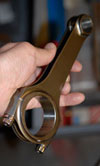Smaller and lighter is always better
 In the case that you don't have this article delivered to your inbox, I hope that the title has drawn you here either in the hope that you will find how to make your con rods smaller and lighter (in which case you may be disappointed) or because you disagree with the fundamental statement of the title.
In the case that you don't have this article delivered to your inbox, I hope that the title has drawn you here either in the hope that you will find how to make your con rods smaller and lighter (in which case you may be disappointed) or because you disagree with the fundamental statement of the title.
Previous articles on the subject of con rods have talked about some of the material choices for these parts, and in the recent magazine Focus article on the subject of con rods, the author discussed the merits of material choice with leading manufacturers of con rods from all over the world. There is a general feeling that reduction of mass and inertia is a good thing, and in very many cases this is true and the title of this article can be taken almost as a 'universal truth' within the limits of maintaining both satisfactory function and sufficient reliability.
For those chasing light weight, low inertia and reduced mechanical loads, there are indeed significant gains to be had from working on the con rod. Light con rods make less demand for counterweighting on the crankshaft and so the any mass saved on the con rod can be carried on through the design of the whole cranktrain. In many forms of motor-racing this is the philosophy that is followed with good results. Low inertia is felt to improve the responsiveness of the engine, making it 'pick-up' quickly when transferring from a closed or neutral throttle to an open one. In a similar vein, low inertia turbine and compressor wheels in turbocharged applications prevent excessive lag and improve responsiveness.
So, are there any racing applications where low inertia and low mass are not primary goals? The answer to this question in a surprising number of motorsport situations is 'yes'. Whilst we can usually be certain that riders / drivers / pilots of racing motorcycles, cars and boats will want more power than their rivals, there is an aspect to performance which is gaining increasing understanding, but is little understood by many (probably most) involved in racing engine design.
When we talk of performance, those involved in engine design alone will generally judge peak power to be the metric by which performance is measured. Those who are perhaps more enlightened may have other methods by which they judge performance. Ideally we ought to judge performance by the stopwatch, because I suspect that there are very few of us who compete on dynamometers alone for any sort of peak power prize (although I have seen an extremely cheap in-house 'Power Cup' awarded to the builder of the most powerful engine) and so our efforts are judged on the track.
To be of greatest use on track, even the most power-hungry engine supplier realises that his product needs to have a certain useful operating range, and this is a step in the correct direction and this represents a loose grasp of the subject of 'driveability' or 'rideability', which goes beyond providing a high output.
There are a number of applications where low inertia is actually a barrier to performance as measured by the stop-watch. In some of these applications we have, by constantly producing parts of lower inertia, not provided what is required. In some instances, we have actually seen titanium con rods being replaced with steel rods, and furthermore the steel rods are specially designed for increased inertia, in order to control engine response. These have proven repeatedly to offer improved performance when measured in terms of lap time and race times. Such con rods appear ungainly to the eye when judged against 'normal' racing con rod designs. However, they do represent a measurable improvement in performance, and so should be judged on their considerable technical and economic merit. Providing a similar gain in laptime by increasing power alone would cost a great deal more in spent treasure.
Fig. 1 - Steel rods may offer real performance gains compared to lighter titanium rods in some applications.
Written by Wayne Ward
Photo courtesy of Auto-Verdi.